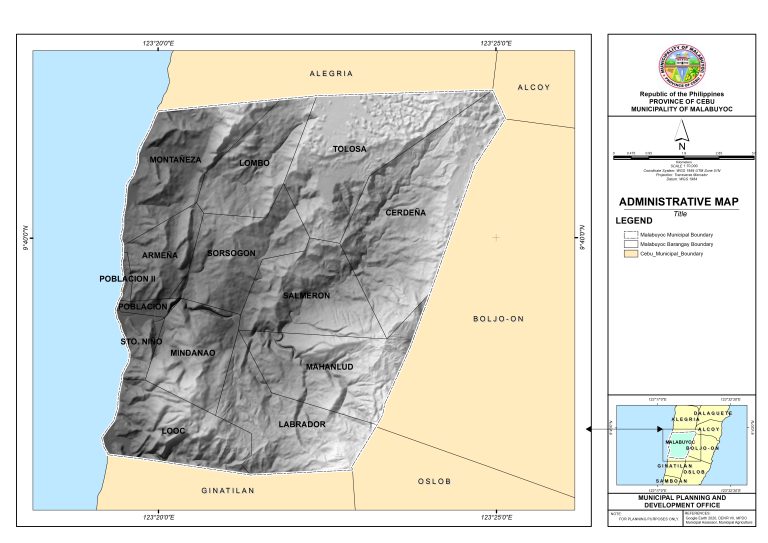Republic of the Philippines
MUNICIPALITY OF MALABUYOC
Province of Cebu

MAYOR'S MESSAGE

As the mayor of the historic and vibrant municipality of Malabuyoc, it is my honor and privilege to extend warm greetings and heartfelt welcome to all.
Rooted in a rich tapestry of legend and history, Malabuyoc’s journey is a testament to the resilience and spirit of its people. Legend has it that our town derived its name from the amalgamation of “mala,” meaning “bad” or “dry” in Spanish, and “buyoc,” signifying the weight of fruit-laden branches. Through the ages, Malabuyoc has grown and flourished, shaped by the hands and hearts of its residents.
Our municipality, officially founded in 1832, carries with it a legacy of community and progress. From its humble beginnings, Malabuyoc has evolved into a dynamic hub of culture, commerce, and opportunity. Guided by the vision and dedication of our forebears, we continue to march forward, embracing the challenges of the present while preserving the heritage of the past.
Nestled along the southwestern coast of Cebu, Malabuyoc boasts a breathtaking landscape characterized by lush forests, fertile farmlands, and pristine coastlines. Our geography not only sustains our agricultural endeavors but also serves as a sanctuary for biodiversity and natural wonders. As stewards of this land, it is our duty to nurture and protect it for generations to come.
Economically, Malabuyoc thrives on agriculture, with vast swathes of our land dedicated to cultivation. Through the toil of our farmers and the support of government initiatives, we strive to enhance productivity while promoting sustainable practices. Moreover, our burgeoning tourism sector, epitomized by the Mainit Springs and Waterfalls, promises new avenues for growth and prosperity.
At the heart of our municipality lies our greatest treasure – our people. With a population of nearly 20,000 souls, Malabuyoc pulsates with vitality and diversity. From the bustling streets of Poblacion to the tranquil hamlets of our barangays, unity and camaraderie bind us together as one community. Through our commitment to education, healthcare, and social welfare, we endeavor to uplift every resident, ensuring a better quality of life for all.
As we stand on the threshold of a new era, let us embrace the opportunities that lie ahead with courage and optimism. Together, let us forge a future where progress is balanced with compassion, where growth is sustainable, and where every dream finds fruition.
In closing, I extend my deepest gratitude to all who contribute to the prosperity and well-being of Malabuyoc. May our journey be guided by wisdom, integrity, and the enduring spirit of bayanihan.
Uswag Malabuyoc!!!
Brief Profile of the Municipality of Malabuyoc
The most popular legend about Malabuyoc tells that once there grew plenty of fruit trees like mangoes, lanzones, cacaos and others. The heavy weight of fruits caused the branches of trees bent heavily down or “buyoc” in Bisaya. On account of this usual sight, the place came to be called “Buyoc”.
The coming of the Spaniards to the village, they were offered some fruits (mango and lanzones) to eat. They liked them so much they ate plenty of these fruits. Some of them suffered stomachache as a result. “Malo” remarked some Spaniards, a Spanish word which means “no good” in English. For one reason or another, the Spaniards called the place “Mala-Buyoc”. Later, by usage, the two words were combined into “MALABUYOC”.
Legal and Socio-Cultural History
According to the book entitled History of Malabuyoc, the name “Malabuyoc” was derived from a Spanish word mala meaning “bad” or “dry” and native words nagbuyoc (meaning “pouring milled corn into the pot”) or buyoc (meaning “weighed down”). Malabuyoc was officially founded in 1832 by Agustin Fuentes, Leon Carbonella, Jose Balentos, Pedro Vildosola and Martin Carredo and it became a pueblo in 1834.
Municipal Governments were reorganized under Act No. 82 of the Philippine Commission dated 30 January 1901. Likewise, provinces were organized under Act No. 83 of the Philippine Commission dated February 6, 1901. Under this Act, government authority was vested on the provincial board which was composed of the governor, treasurer and supervisor. On the bases of these directives, Malabuyoc together with 32 other towns that had not been reorganized under earlier orders, were organized as towns on January 30, 1901. From the Executive Order No. 952, Malabuyoc remain a town without gaining new territory.
Geography
Malabuyoc has a total land area of about 8,341 hectares with 3,545 hectares classified as Alienable and Disposable lands equivalent to 42.5 % of the total land area and 4,796 hectares of Forestland covering 57.5% of the total land area. Natural growth forest covering approximately 426.2 hectares is distributed at the A&D and Forestland areas throughout eleven barangays in the municipality but more concentrated in Barangays Cerdena, Looc, Salmeron, Lombo, Montaneza, Mindanao and Sorsogon. The dominant species are ipil-ipil, molave, narra and antipolo. “Kaingin” (slash and burn farming), a shifting kind of agriculture accounts for most of the forest destruction. The forest between Mindanao and Poblacion.Uno serves as protection for the water catchment that supplies water to the Municipal Water System catering about 1,500 households in the coastal barangays of Malabuyoc.
Malabuyoc a fourth-class municipality, is 125 kilometres away from Cebu City is located at the south-western coast of Cebu, an island province of Region 7, the Central Visayas Region. This municipality belongs to the seventh congressional district and is in between the Municipalities of Alegria and Ginatilan. On the eastern border are the mountains of the Municipalities of Alcoy, Boljoon and Oslob. On the western side is the Tañon Strait.
Economy
Malabuyoc’s economy is largely dependent on agriculture. About 6,712 hectares, constituting 80.5% of the municipality’s total land area of 8,341 hectares is devoted to agricultural production. About half of the area is planted with rice, corn, root crops, banana and vegetables while the other half is devoted to plantation/orchard and perennial crops. Mono cropping system is still the dominant farming technique employed by farmers. Livestock production is still small scale (backyard raising). Modern farming techniques are gaining acceptance through the technical assistance programs of the Department of Agriculture. Incipient commercial activities are concentrated in the central barangays of Poblacion I and II. Business establishments predominantly deal with services and trading. An emerging tourist destination at Sitio Mainit, Barangay Montaneza is being developed by the Local Government Unit of Malabuyoc in coordination with the Department of Tourism (DOT) and the local stakeholders. It is named as the Mainit Springs and Waterfalls and expected to generate more jobs and additional income and revenues to the local community.
Population and Demography
Malabuyoc has a total population of 19,770 and 4,463 households as per NSO Census of 2020. A Main Health Centre is strategically located at Poblacion Dos behind the new Malabuyoc People’s Palace. Beside is the Municipal Birthing Centre where all child deliveries are being done aside from the 25-bed capacity of the Mariano Jesus Cuenco Memorial Hospital, a district hospital managed by the Cebu Provincial Government, doing primary health care services to the local constituents and the neighboring municipalities as well. Public elementary education is served by 11 elementary schools and four (4) primary schools distributed over the 14 barangays of the municipality. Secondary level education is provided through five (5) high schools, four (4) public and one (1) private school. A tertiary education of Cebu Technological University-Malabuyoc Campus is now serving the municipality and to the adjacent municipalities like Alegria, Ginatilan, Samboan and as far as Santander going south. Cebu Electric Cooperative II supplies the electricity in the 14 barangays of Malabuyoc. As of 2020, about 70 to 80% households are being served with electricity in the upland barangays and 90% in the coastal barangays.
Administrative Map

